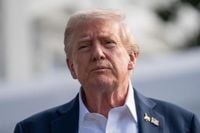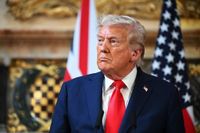With the clock ticking down to a September 30 deadline, Washington is once again bracing for a government shutdown. President Donald Trump has taken a combative tone, blaming Democrats for the looming crisis and accusing them of pushing for funding that would benefit undocumented immigrants and expand access to gender-affirming healthcare. The battle lines are drawn, and both sides appear unwilling to budge, setting the stage for a high-stakes showdown that could have sweeping consequences for federal workers, the economy, and the American public.
On September 26, 2025, President Trump made his position clear: if Congress fails to pass a budget, he says Democrats will be to blame. According to CBS News, Trump alleged that Democrats "want to funnel funds to undocumented immigrants," a charge that has become a recurring theme in his rhetoric. The president has also repeatedly brought up gender-affirming healthcare, telling reporters, "if it has to shut down, it'll have to shut down," and accusing Democrats of wanting "to have transgender for everybody," calling them "crazy," as reported by Forbes. While the specifics of these claims remain somewhat murky, Politico has noted that some Trump allies argue an extension of federal tax credits in the Affordable Care Act would continue taxpayer support for gender-affirming healthcare, since several states require insurance to cover such services.
The standoff has escalated dramatically in recent days. On Wednesday night, September 24, the White House budget office issued a memo directing federal agencies to prepare for mass firings should a shutdown occur. This memo, first reported by CNN, marked a significant escalation in the funding battle and provided the first public glimpse into the Trump administration’s internal operational planning. The memo instructed agencies to identify programs whose discretionary funding would expire on October 1, and to focus on eliminating functions not explicitly mandated by law, echoing a February directive that called for "the maximum elimination of functions that are not statutorily mandated while driving the highest-quality, most efficient delivery of their statutorily-required functions."
OMB Director Russ Vought and other administration officials have long advocated for workforce reductions, and the potential shutdown offers an opportunity to pursue these cuts on a scale previously considered politically unpalatable. As Douglas Holtz-Eakin, president of the American Action Forum and a longtime GOP policy adviser, told CNN, "You could fire people now, you could fire people in December, you could do the large-scale reductions in force at any time. But it’s now part of rhetorical positioning that the White House has chosen."
On Capitol Hill, reactions have been mixed. GOP Senator Bernie Moreno of Ohio warned that if the shutdown drags on, "we’re going to have to make permanent cuts," including the layoffs described in Vought’s memo. He placed the blame squarely on Democrats, arguing that "the onus is on congressional Democrats to accept the House-passed stop gap funding package to avert a shutdown." Moreno added, "If the Democrats continue to hold this hostage for obscene amounts of spending, then we’re going to have to make changes to the way the federal budget is structured."
Not all Republicans are comfortable with the administration’s hardline tactics. Senator Susan Collins of Maine, who leads the Senate spending panel, cautioned that federal employees "should not be treated as pawns" in the funding fight. Some GOP strategists worry that the White House’s rhetoric and threats of mass firings could backfire, especially if layoffs impact services that directly affect voters’ daily lives. "Trump is going to exert whatever power he can, he’s going to exact whatever pain he can," GOP strategist Doug Heye told CNN. "That could backfire — and there’s certainly the risk of that especially if we start seeing firings in areas that we haven’t seen before that directly impact voters’ lives."
Democratic leaders, meanwhile, have dismissed the OMB memo as little more than a scare tactic. House Minority Leader Hakeem Jeffries told CNN, "We will not be intimidated by Russ Vought, who is completely and totally out of control. The OMB has been illegally shutting down parts of the government throughout the entire year, and the notion that Democrats are going to be intimidated by this guy, when all he has done is send a message to voters in Virginia and across the country that Republicans are determined to hurt the American people." According to multiple Democratic aides, the threat of mass firings has only strengthened their resolve not to yield to GOP demands without securing a win on health care policy.
The Senate has thus far rejected proposals from both parties to keep the government open. The Republican plan failed in a 44-48 vote, while the Democratic plan was also rejected, with several Republican senators missing the vote, according to Forbes. The House, however, passed the GOP-backed continuing resolution in a narrow 217-212 vote. President Trump canceled a planned meeting with congressional Democratic leaders, accusing them of making "unserious and ridiculous demands" in exchange for their votes to keep the government running.
If Congress does not approve a new spending plan before the deadline, the consequences could be far-reaching. All non-essential federal workers would be furloughed, while essential employees, such as military personnel and airport security staff, would be required to work without pay until the shutdown ends. TSA and air traffic control workers are expected to be deemed essential, but would not receive paychecks during the closure, as reported by CNN. National parks and museums would likely close or operate with reduced services, and agencies like the Federal Housing Administration would stop processing new loans. Routine inspections by the Food and Drug Administration and Environmental Protection Agency could be curtailed or halted entirely. During the last shutdown in December 2018, which lasted a record 35 days, some air traffic controllers and TSA officials stopped showing up for work, causing significant flight delays at major airports. Tourism officials estimate that disruptions in travel and closures of parks and museums could cost the economy $1 billion in the event of a shutdown.
For Democrats, the shutdown presents both risk and opportunity. As Forbes notes, forcing a shutdown is one of the few tools available to them to counter Republicans, who currently control all three branches of government. Democrats, polling at historic lows, may see the crisis as a chance to demonstrate resistance to the Trump administration and rebuild their image ahead of the 2026 midterm elections. However, shutdowns are generally unpopular with voters, and the political fallout remains unpredictable.
The Trump administration’s approach to the standoff is unmistakably aggressive, using the threat of mass firings and service disruptions as leverage to force Democrats’ hand. As Jack Goldsmith, a Harvard Law professor and former Justice Department official, wrote on X, "An administration happy to downsize and to shed federal government employees has an asymmetric weapon against Congressional government shutdown threats." The administration’s willingness to use that weapon, and the Democrats’ determination not to back down, have left the country teetering on the brink of another costly and disruptive shutdown.
With the deadline just days away, the nation waits to see which side will blink first—or if anyone will at all. The fate of hundreds of thousands of federal workers, vital public services, and the broader economy hangs in the balance as partisan brinkmanship reaches a fever pitch in Washington.



